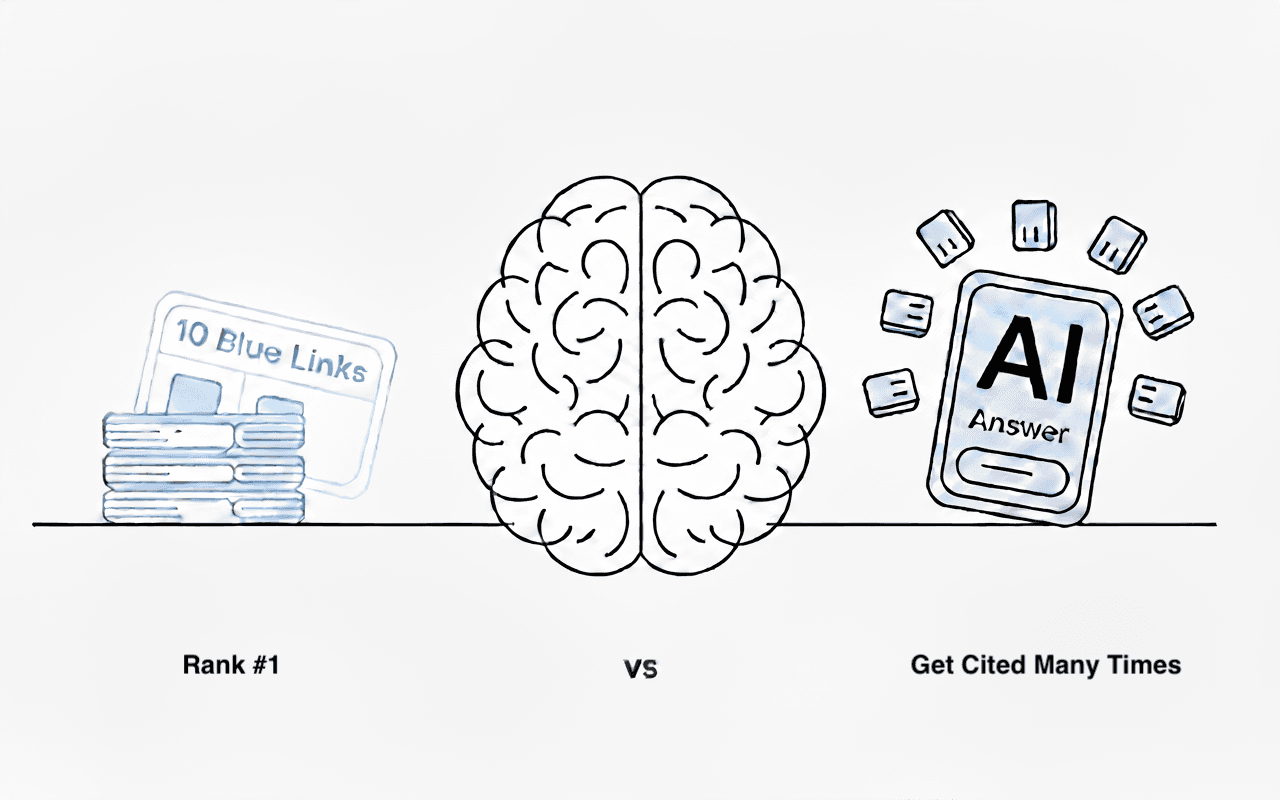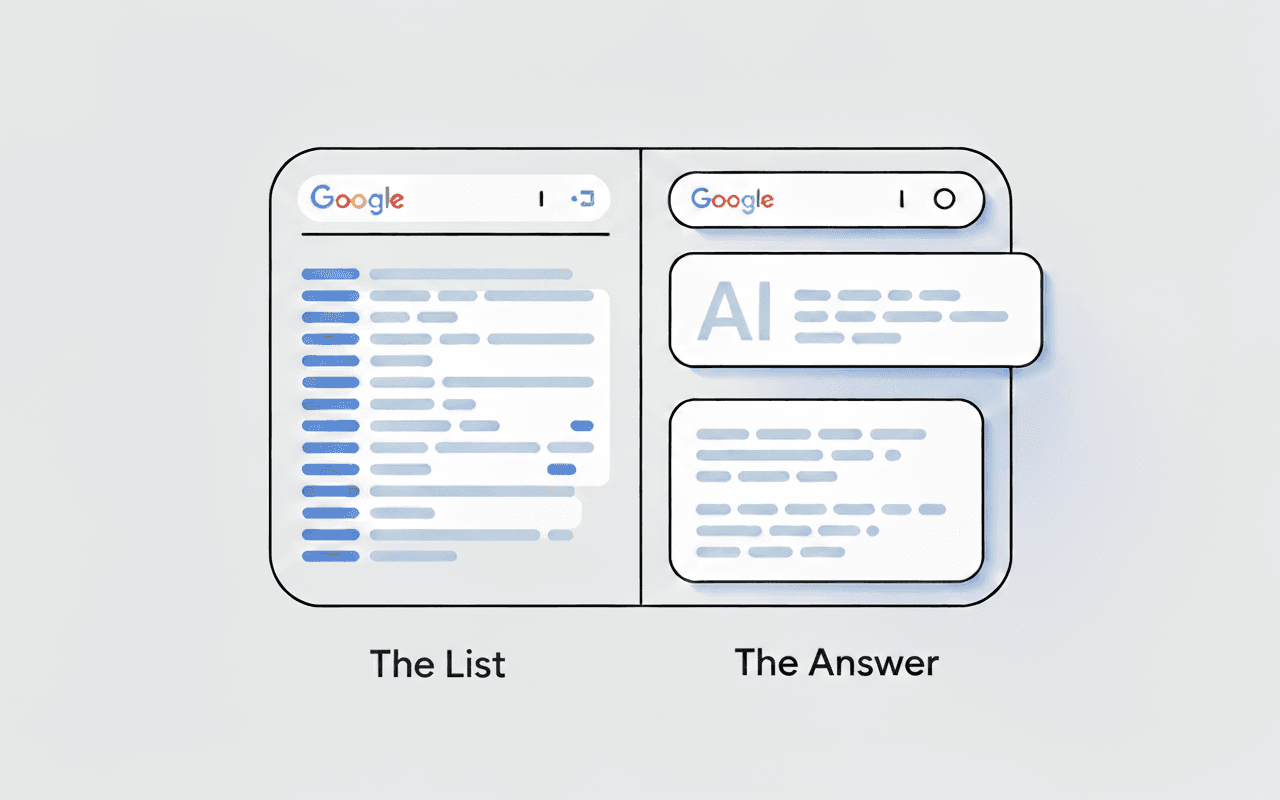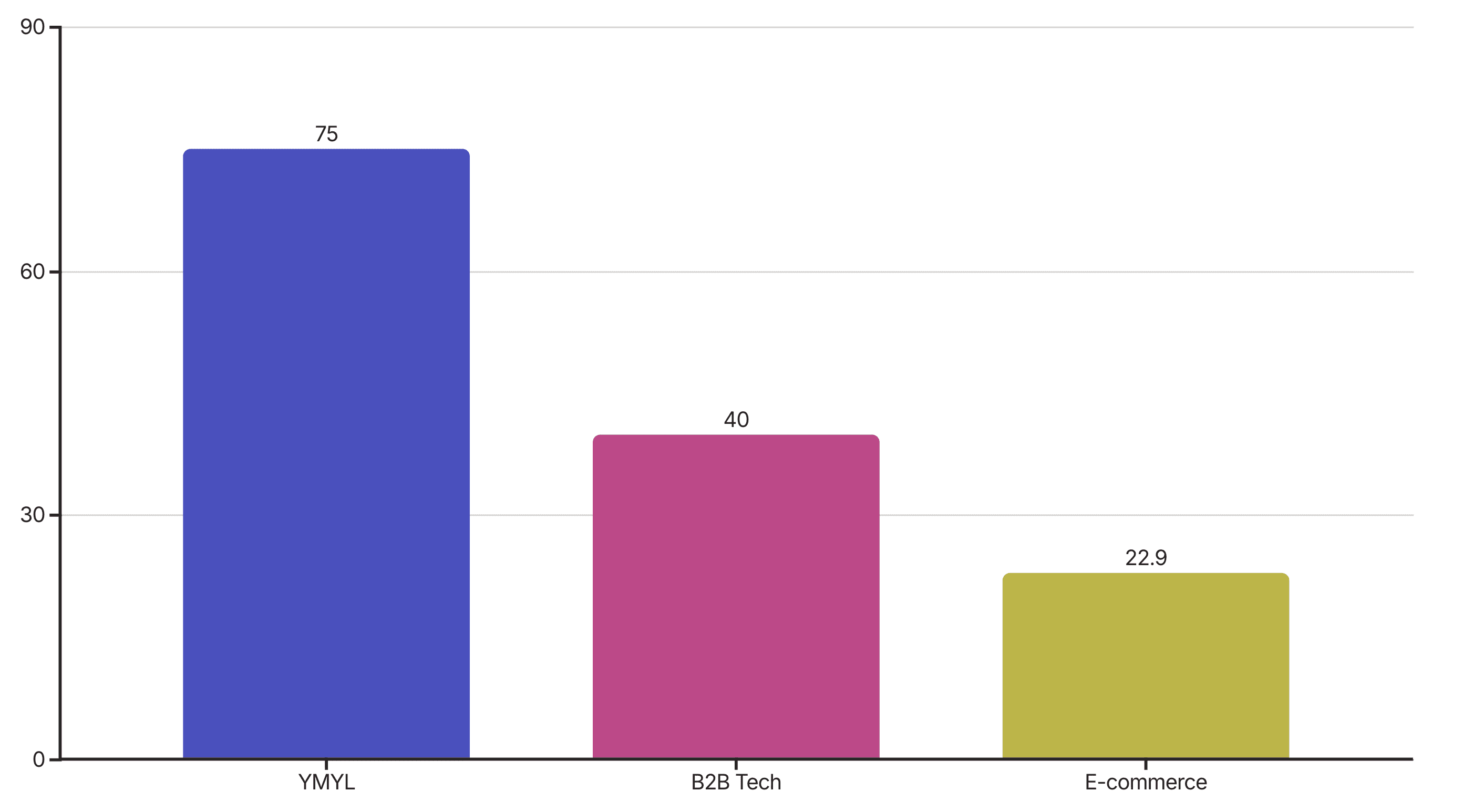AI Share of Voice: The Definitive Guide to Measuring & Improving Your Visibility in 2025
Master AI Share of Voice (SoV), the new KPI for AI search visibility. Learn why citations are the new rankings and get a 90-day plan to measure & improve your AEO.
Prerequisites

In traditional SEO, the mantra was "rank #1 or die." In the new era of AI search optimization, the reality is "get cited multiple times or you don't exist."
For years, success was measured by a simple set of metrics: keyword rankings, click-through rates, and organic traffic. However, tracking your position in a list of 10 blue links is becoming irrelevant in a world where users often never see that list. With Gartner predicting search volume may drop by 25% due to zero-click answers, the traffic that remains has fundamentally shifted in nature.
The landscape has moved from Volume to Value.
Users receive a single, definitive answer synthesized from multiple sources—the new moment of maximum influence. While traffic volume may decrease, the quality increases; users clicking through from an AI answer are pre-qualified. Early data suggests this traffic can convert at rates 23x higher than traditional search.
If your brand isn't a source for that answer, you are invisible. This focus on citation and visibility within AI answers is the core of a new discipline: Answer Engine Optimization (AEO).
To succeed, you must adopt a new primary KPI: AI Share of Voice (SoV). This guide provides a comprehensive framework to shift your mindset from chasing keyword rankings to strategically building your presence inside the AI's answer.
TL;DR
- AI Share of Voice (SoV) is the new primary KPI, replacing traditional keyword rankings in the age of AI answers.
- Success is measured by citation frequency, not a #1 position. Being cited multiple times is more valuable than a single top ranking.
- Improving AI SoV requires optimizing for "extractability", structuring content in concise, machine-readable formats.
- You can start measuring AI SoV today with a simple prompt bank and spreadsheet.
Why Rankings Are the Wrong Metric
The core reason old metrics are failing is a fundamental shift in how users receive information. The paradigm has flipped from a list-based model to an answer-based model, and this changes everything.
The Fundamental Shift: The List vs. The Answer
- Traditional Search (The List): A user enters a query and is presented with a list of options (the 10 blue links). They must evaluate these options and click ONE to find their answer. The primary goal for marketers was to win that single, decisive click by securing the #1 position.
- AI Search (The Answer): An AI engine like Google's AI Overviews, ChatGPT, or Perplexity receives a query and synthesizes information from 5-10 different sources to create a single, definitive answer. The user's need is met directly. The goal for marketers is to be one of those trusted sources that informs the final answer.

The Implication: Frequency Over Supremacy
In this new model, the value of a single #1 ranking diminishes significantly. That top spot is now just one of many inputs into an answer the user reads. A far more powerful position is to be cited multiple times from different sources within a single AI answer.
Imagine a user asks, "What is the best CRM for a small business?" Being cited three times from your blog, a positive Reddit thread, and a YouTube tutorial is exponentially more valuable than simply ranking #1 on Google for the same query. Multiple citations signal broad authority and trustworthiness to both the AI and the user.
Beyond the Click: The Diminishing Primacy of Traffic
AI Overviews and chatbots are explicitly designed to satisfy user intent without them ever needing to leave the results page. While this doesn't mean the "death of the click," many answers still encourage deeper research, it marks the end of the click as the primary measure of visibility. If the user's need is met by the AI's answer, there may be no click to your site. Therefore, traditional traffic-based metrics like CTR and organic sessions become unreliable indicators of your influence. The new metric must be based on what happens before a potential click: citation and mention frequency. Your brand's value is no longer measured by the traffic you receive, but by the trust you command.
What is AI Share of Voice? (And How to Measure It)
To navigate this new landscape, you need a new compass. AI Share of Voice is that compass.
Core Definition
AI Share of Voice (SoV) is a metric that measures the percentage of target user queries for which a brand is cited as a source in an AI-generated answer, benchmarked against its competitors. It measures your brand's presence and authority within the AI conversation itself.

How to Calculate Basic AI SoV
You can start measuring your baseline AI SoV today with a simple, four-step process:
- Define a Prompt Bank: Identify 50-100 high-intent questions your Ideal Customer Profile (ICP) asks. Focus on bottom-of-the-funnel queries like "best X for Y," "how to solve Z," or "X vs. Y."
- Query the Engines: Run these prompts through your target AI engines. Start with Google AI Overviews, ChatGPT, and Perplexity, as they have distinct user bases and sourcing biases.
- Track Mentions: For each prompt, create a simple spreadsheet and record which brands (you and your key competitors) are cited as a source in the generated answer.
- Calculate Your Score: Use this simple formula to find your baseline:
Your AI SoV % = (Number of Prompts Where You Are Cited / Total Number of Prompts) * 100
Advanced AEO Metrics
Simple mention counting is a great start, but a sophisticated AEO strategy requires a more nuanced measurement framework. To truly understand your performance, you need to track not just if you were mentioned, but how.
| Metric | What It Measures | Why It Matters |
|---|---|---|
| AI Citation Count | Raw number of times your brand/URL is cited. | Provides a baseline for visibility and tracks raw growth over time. |
| AI Share of Voice (SoV) | Your percentage of all competitor citations. | Defines your market share of the AI conversation and benchmarks you against rivals. |
| Weighted Reciprocal Score | Gives more weight to citations that appear earlier in an answer (e.g., 1st citation = 1.0, 2nd = 0.5, 3rd = 0.33). | Measures the prominence and impact of your citations. An early mention is more influential. |
| Citation Diversity | The number of unique domains/sources citing you (e.g., your website, YouTube, Reddit, a Forbes article). | Shows the breadth of your authority. Relying on a single source is risky. Diversity builds a defensible moat. |
| Sentiment Score | The context of the mention (positive, neutral, negative). | Crucial for brand health. AI models are trained on vast datasets from the internet and can inherit and amplify existing societal biases. They can also frame brand mentions in a negative context, which requires immediate attention. |
The Connection Between Google Rankings and AI Mentions
This is the question every SEO professional is asking: Does my Google rank still matter for getting cited by an AI? The answer is nuanced: it depends heavily on your industry.
The YMYL Correlation
In high-stakes "Your Money or Your Life" (YMYL) sectors like Healthcare, Finance, and Insurance, the answer is a resounding yes. A 16-month study by BrightEdge found that the overlap between top organic rankings on Google and citations within AI Overviews is as high as 75%. For these industries, AI engines are risk-averse. They heavily favor sources that have already been vetted by Google's core algorithms and demonstrate strong E-E-A-T (Experience, Expertise, Authoritativeness, Trustworthiness). In YMYL, strong traditional SEO is a prerequisite for AEO success.
The E-commerce Disconnect
In stark contrast, the E-commerce sector tells a different story. The same BrightEdge study found the overlap between top organic rankings and AI citations is only 22.9%. This suggests that for transactional queries, Google is intentionally separating its informational AI Overviews from its product-focused organic results. The AI might answer "how to choose the best running shoes" by citing blogs and publications, while the organic results below feature product pages from Nike and Adidas.
The B2B Tech Hypothesis
For B2B Tech and SaaS, our analysis shows the overlap is around 40%. While not life-or-death, AI engines still prioritize authoritative, expert-driven content for complex business decisions, making high-ranking guides and whitepapers prime sources. However, they may also pull from community sources like Reddit or forums for practical implementation advice and user sentiment, creating a more blended sourcing model than in YMYL or E-commerce.

The Takeaway
You can absolutely improve your AI Share of Voice without improving your Google rankings, especially in non-YMYL fields. By focusing on the sources that AI engines love, like Reddit, Quora, and other forums, you can build visibility directly within the answer engine's ecosystem. However, for authoritative topics where trust is paramount, a high Google rank remains one of the most powerful signals you can send to an AI.
How AI Engines "Rank" Sources: A Look Inside the Machine
Many marketers are asking about "ChatGPT ranking factors." This question is based on a misconception. AI engines don't "rank" sources in a list like Google. They select and synthesize information from multiple sources to build an answer.
To measure your success, you must understand the one phase of the this process you can control: Extractability.
Unlike a human reader who scans a whole page, the AI's Retrieval (RAG) layer looks for discrete 'chunks' of information it can lift to build an answer. Your content does not need to 'read well' narratively; it needs to be 'extractable.'
The Metric to Watch: In your monitoring tools, track not just if you are cited, but which specific text block was pulled. If the AI consistently ignores your 2,000-word guide but cites your competitor's 3-sentence definition, your content has low Extractability.

What This Means for Optimization
The RAG process makes it clear what your content needs to do to get cited. It must be discoverable, relevant, authoritative, and extractable.
Be Discoverable
Your site must have strong technical SEO so AI crawlers can easily find, render, and index your content. This includes a clean site architecture, fast page speeds, and a comprehensive sitemap.
Be Relevant
Your content must align with the concepts, entities, and language of the user's prompt. This involves deep topic research and understanding the semantic relationships between different user questions.
Be Authoritative
Your content must pass the AI's E-E-A-T filters, signaling that you are a trustworthy source of information. This is achieved through expert authorship, comprehensive coverage, and earning backlinks from other authoritative sites.
Be Extractable
This is the new frontier. Your content must be formatted so an AI can easily "lift" a clean, self-contained answer block. Use short paragraphs, clear definitions, bulleted lists, and FAQ schema to make your answers easy for a machine to parse and repurpose.
The Power of Extractability: A Before-and-After Example
Consider how a simple change in formatting can make your content dramatically more AI-friendly.
Before: A Dense, Narrative Paragraph
Our company's innovative CRM platform is a comprehensive solution designed for modern sales teams. It integrates various functionalities, including lead management, which helps track potential customers through the sales funnel, and contact management, which organizes all customer information in one place. Furthermore, it offers robust analytics and reporting features, giving managers deep insights into team performance and sales trends, ultimately driving efficiency and revenue growth across the organization.
After: An AI-Optimized, Extractable Format
What is Our CRM Platform? Our CRM platform is a comprehensive solution designed to help modern sales teams drive efficiency and revenue growth.
Key Features:
- Lead Management: Track potential customers through the entire sales funnel.
- Contact Management: Organize all customer data, interactions, and history in a single, unified view.
- Analytics & Reporting: Gain deep insights into team performance, sales trends, and forecasting.
The "After" version is structured for an AI to easily identify the core definition and key features, making it a prime candidate for citation.
How to Improve Your AI Share of Voice: A 90-Day Roadmap
Improving your AI SoV is not a vague, long-term goal. It can be tackled with a structured, sprint-based approach that delivers measurable results in as little as 30-90 days for specific queries.
Choosing the Right AEO Tools
Before you begin, it's crucial to have the right technology. An emerging landscape of AEO tools can automate tracking and provide deeper insights. When evaluating platforms, prioritize those that offer multi-engine coverage, methodological transparency, and auditable data.
| Tool | Key Differentiators | Best For |
|---|---|---|
| Profound | Tracks brand performance and citation context across five major engines; offers "Answer Engine Insights". | Content strategists needing to understand source preferences. |
| Birdeye | Excels at prompt-based audits, accuracy checks, and sentiment analysis; provides screenshots for auditable records. | Businesses focused on local search and reputation management. |
| GAIO Tech | Provides fully disclosed, auditable methodology with weighted reciprocal scoring and cross-AI benchmarking. | Large teams managing hundreds of critical customer queries. |
Phase 1: Baseline & Triage (Weeks 1-2)
- Action: Choose an AEO tracking tool or build a manual tracking spreadsheet. Define your initial 50-question prompt bank, focusing on high-intent, bottom-of-funnel questions.
- Goal: Get your baseline AI SoV score. Identify your biggest "citation gaps," the critical customer questions where your competitors are consistently mentioned and you are not.
Phase 2: Quick Wins (Weeks 3-6)
- Action: From your triage list, identify the top 5 questions where you have zero visibility but a high potential for impact. Your goal is to create or optimize content specifically to answer them.
- Tactics:
- On-Page: Find an existing, relevant landing page. Refactor it to include a clear, concise answer in the first few paragraphs. Add an FAQ section with schema markup to explicitly target the question.
- Off-Page: Find a relevant, high-ranking Reddit thread on the topic and provide a genuinely helpful, non-spammy answer that links back to your newly optimized resource. Create a short (1-2 minute) YouTube video that answers the question directly.
Phase 3: Competitive Displacement (Weeks 7-12)
- Action: Now, target the questions where a single competitor dominates the citations. Your goal is to push them out by providing a superior answer.
- Tactics: Create a "10x" piece of content that is more comprehensive, better researched, and more clearly formatted than your competitor's. Promote this new asset across multiple channels (your blog, a guest post, a video, social media) to build a diverse citation profile that demonstrates broader authority to the AI.
Phase 4: Scale & Defend (Ongoing)
- Action: Expand your prompt bank to 200+ queries to cover a wider range of customer intents. Automate your tracking and reporting to monitor your SoV over time.
- Goal: Build a "citation moat" around your core topics. By becoming the most frequently cited and diverse source, you make it incredibly difficult for new competitors to enter the AI conversation.
Comparison: Traditional SEO vs. Answer Engine Optimization (AEO)
The shift to AEO requires a fundamental change in mindset, strategy, and measurement. This table summarizes the key differences.
| Factor | Traditional SEO Focus | AEO Focus |
|---|---|---|
| Primary Goal | Rank a URL in the top 10 links. | Become a cited source in the generated answer. |
| Success Metric | Keyword Ranking, Organic Traffic, CTR. | AI Share of Voice, Citation Count, Sentiment Score. |
| Content Strategy | Long-form, keyword-optimized blog posts. | Factual, concise, easily extractable answer blocks. |
| Keyword Focus | Short-tail and long-tail keywords. | Conversational, full-sentence questions and prompts. |
| Competitive View | Who ranks above me on the SERP? | Who is mentioned more often in AI answers? |
| Time to Impact | 6-12 months for competitive terms. | 30-90 days for specific, targeted queries. |
Conclusion
The age of obsessing over your rank in a list is over. It's time to start obsessing over your share of the definitive answer. AI Share of Voice is not just another metric. It is the new leading indicator of brand trust, authority, and future market share. While your competitors are still chasing the #1 spot on a SERP that users may never see, you have the opportunity to become the voice of authority inside the answer itself.
The early-mover advantage in this space is massive. The brands that establish themselves as the go-to source for AI engines today will build a defensible moat that will be difficult for others to cross tomorrow. Looking ahead, this discipline will evolve to include measuring SoV in multimodal results (like AI-generated images and videos) and using structured data more deeply as a primary input for AI answers. Your competitors are likely not tracking this yet, which gives you a critical window to act.
Your first step is simple. Take 10 of your most important customer questions, ask them to ChatGPT and Google, and see who shows up. That's your starting line. The race for the future of visibility has already begun.
